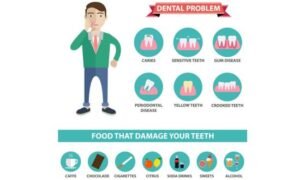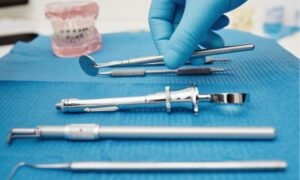A receding gum line is when the gums pull back from the teeth, exposing more of the tooth or its root. This can cause tooth sensitivity, decay, and even tooth loss. However, there are several ways to prevent and stop the progression of a receding gum line. This article will give you a detailed insight on “How to stop a receding gum line?”
What is Gum Recession?
Gum recession refers to the gradual loss or pulling back of the gum tissue surrounding the teeth. This can lead exposing more of the tooth or its root. If left untreated, this condition can lead to increased tooth sensitivity, cosmetic concerns and potential dental issues like decay or tooth loss.
What Causes Receding Gums?
Receding gums occur when the gum tissue around the teeth wears away or pulls back, exposing the roots of the teeth. This can be caused by various factors, including:
- Poor oral hygiene
- Gum disease (gingivitis or periodontitis)
- Brushing too hard
- Hormonal changes
- Tobacco use
- Genetics
- Grinding or clenching teeth
- Crooked teeth or a misaligned bite
How to Tell If You Have Gum Recession?
Symptoms of gum recession typically include:
- Visible Changes: Teeth appearing longer or larger due to the receding gum line, making the tooth roots more exposed.
- Increased Tooth Sensitivity: Heightened sensitivity to hot, cold, or sweet foods and drinks due to exposed roots.
- Gum Bleeding or Swelling: Bleeding or swelling along the gum line, especially during brushing or flossing.
- Notching Near Gum Line: Indentations or notches appearing at the gum line, indicating tissue loss.
- Loose Teeth: In advanced cases, teeth may become loose or shift due to diminished gum support.
Gum Recession Stages
Gum recession occurs gradually, progressing through various stages that indicate the severity of tissue loss around the teeth. These stages include:
- Stage 1 – Mild Recession:
- Minimal gum tissue loss with the gum margin slightly pulled away from the tooth.
- Often asymptomatic or accompanied by mild sensitivity.
- Stage 2 – Moderate Recession:
- Noticeable gum tissue loss, leading to more exposure of the tooth’s root.
- Increased tooth sensitivity and potential aesthetic changes (longer-looking teeth).
- Stage 3 – Severe Recession:
- Significant loss of gum tissue, exposing a larger portion of the tooth’s root.
- Pronounced sensitivity, increased risk of decay, and potential bone loss around the affected teeth.
How to Diagnose Gum Recession?
Diagnosing gum recession involves a visual examination by a dentist or periodontist. Key steps in the diagnosis are:
- Visual Examination: Dentists visually inspect the gums, looking for signs of recession such as exposed tooth roots or changes in gum appearance.
- Gum Pocket Measurement: Using a dental probe, they measure the depth of the spaces between the gums and teeth (gum pockets).
- X-rays: X-rays may be taken to assess any bone loss around the teeth, aiding in determining the extent of gum recession.
- Symptom Evaluation: Dentists consider symptoms reported by the patient, like tooth sensitivity or bleeding gums, as part of the diagnosis.
- Dental History: Your dental history, including previous gum issues or treatments, is taken into account for a comprehensive diagnosis.
- Regular Check-ups: Routine dental check-ups are crucial for early detection and monitoring of gum health to diagnose gum recession promptly.
Tips to Prevent Receding Gums
Maintain Good Oral Hygiene
Taking care of your teeth and gums is crucial in preventing gum recession. Here’s how:
- Brushing: Use a soft-bristled toothbrush and gentle, circular motions. Avoid brushing too hard.
- Flossing: Clean between your teeth daily to remove plaque and prevent gum disease.
- Regular Dental Check-ups: Visit your dentist regularly for check-ups and professional cleanings.
Healthy Lifestyle Changes
Certain lifestyle adjustments can help maintain healthy gums:
- Quit Smoking: Tobacco use can contribute to gum disease and recession. Seek help if needed to quit smoking.
- Balanced Diet: Eat a well-balanced diet rich in fruits and vegetables to provide essential nutrients for gum health.
- Reduce Stress: Manage stress as it can lead to teeth grinding, which can contribute to gum recession.
Be Mindful of Dental Care Habits
Some habits can exacerbate gum recession. Be cautious of:
- Proper Brushing Technique: Use gentle, circular motions while brushing. Avoid aggressive brushing.
- Using the Right Toothbrush: Opt for a soft-bristled toothbrush to prevent enamel erosion and gum damage.
- Mouth Guards for Grinding: If you grind your teeth, consider wearing a mouth guard at night to protect your teeth and gums.
How to Stop a Receding Gum Line?
Gum recession treatment is done to achieve following goals:
- Halt the progression of recession
- Protect exposed tooth roots
- Potentially restore lost gum tissue
Treatment Options for Receding Gums
The treatment options vary depending on the severity of the recession and individual patient needs. Some common treatments include:
A. Essential Oils for Gum Recession
Some essential oils possess antibacterial, anti-inflammatory, and soothing properties that may aid in managing gum health. However, it’s important to use them cautiously and under the guidance of a dental professional. Here are a few essential oils that might be beneficial:
- Tea Tree Oil: Known for its antimicrobial properties, tea tree oil may help combat bacteria that contribute to gum disease. Diluted tea tree oil can be used as a mouthwash or added to toothpaste.
- Peppermint Oil: With its refreshing taste and antimicrobial qualities, peppermint oil might assist in reducing bacteria in the mouth. It’s often an ingredient in natural toothpaste or mouthwashes.
- Clove Oil: Recognized for its analgesic and antibacterial properties, clove oil may provide relief from gum discomfort and reduce inflammation. However, it should be used sparingly due to its potency.
- Eucalyptus Oil: Eucalyptus oil may possess anti-inflammatory properties, potentially aiding in reducing gum inflammation. It can be diluted and used as a mouth rinse.
Before using essential oils for gum health, it’s essential to:
- Dilute them properly to avoid irritation or allergic reactions.
- Perform a patch test to ensure you’re not allergic to the oil.
- Consult with a dentist or healthcare professional to understand the appropriate usage and potential side effects.
B. Over-the-Counter Products to Treat Gum Recession
Certain products can aid in managing gum recession:
- Desensitizing Toothpaste: Helps with tooth sensitivity caused by receding gums.
- Antibacterial Mouthwash: Helps reduce bacteria in the mouth, preventing gum disease.
C. Non-Surgical Treatments for Gum Recession
- Scaling and Root Planing:
- A deep cleaning procedure that removes plaque and tartar from below the gum line to prevent further gum recession.
- Helps in reducing bacterial infection and inflammation.
- Antibacterial Mouthwash:
- Helps control bacteria in the mouth, reducing the risk of gum disease and slowing down recession.
- Desensitizing Toothpaste:
- Toothpaste formulated for sensitive teeth can alleviate discomfort caused by exposed tooth roots.
- Lifestyle Changes:
- Quitting smoking and maintaining a balanced diet can contribute to improved gum health.
D. Surgery for Gum Recession
1. Gum Graft Surgery:
Gum graft surgery involves covering exposed tooth roots with tissue to treat gum recession. Here’s a quick look at the procedure:
- Types of Grafts: Connective tissue, free gingival, and pedicle grafts are common options.
- Procedure: Involves taking tissue from the palate or nearby area and stitching it over the exposed roots.
- Post-Surgery Care: Pain management, soft diet, gentle oral hygiene, and follow-up visits are essential.
- Recovery: Full healing takes several weeks, with initial discomfort that usually subsides within days.
2. Pinhole Surgical Technique (PST):
-
- A minimally invasive procedure where the gum tissue is gently repositioned over the exposed roots using specialized instruments.
- Requires no incisions, leading to quicker recovery compared to traditional grafting methods.
3. Regenerative Procedures:
-
- Involves using membranes, grafts, or proteins to stimulate the growth of new tissue and bone.
- Aims to regenerate lost gum and bone tissue around the affected teeth.
4. Gum Tissue Regeneration:
-
- Some advanced treatments involve using proteins or growth factors to encourage the growth of new gum tissue.
Recovery and Aftercare of Surgery for Gum Recession
- Post-Surgical Care: Following the specific instructions provided by the dentist or periodontist is crucial for proper healing.
- Oral Hygiene: Maintaining good oral hygiene with gentle brushing, flossing, and using prescribed mouthwash is essential.
- Follow-Up Visits: Regular check-ups with the dentist allow monitoring of progress and making any necessary adjustments to the treatment plan.
- Recovery Time: Recovery time from gum grafting surgery can vary but usually takes around one to two weeks.
Cost of Gum Grafting Surgery
The cost varies based on factors like the severity of recession and the type of procedure needed. It’s best to consult your dentist for a personalized estimate. On average a typical gum tissue graft can cost between 600$ – 1200$ per tooth.
FAQs
- What is the best toothpaste for gum recession?
Look for toothpaste specifically designed for sensitive teeth, often containing ingredients like potassium nitrate or stannous fluoride.
- What is the best mouthwash for gum recession?
Consider an alcohol-free, antibacterial mouthwash to reduce bacteria and plaque without causing further irritation.
- What are the best products for gum recession?
Desensitizing toothpaste, alcohol-free mouthwash, and soft-bristled toothbrushes are recommended. Consult a dentist for personalized recommendations.
- Can you get braces with gum recession?
Yes, but ensure proper gum health before braces. An orthodontist may suggest treatments to manage recession during orthodontic care.
- Can grinding teeth cause gum recession?
Yes, teeth grinding (bruxism) can apply excessive pressure, contributing to gum recession. Using a mouth guard can reduce this risk.
- Can flossing cause gum recession?
Aggressive flossing techniques may contribute to gum recession. Gentle and proper flossing, guided by a dentist, helps prevent it.
- Can you reverse gum recession?
While treatments like gum grafts can improve it, complete reversal might not be possible. Early intervention is crucial for managing gum recession effectively.
For any further query about this condition feel free to contact us at https://medicalinquiries.com/contact-us/
Bottom Line
Taking care of your gums is an essential part of maintaining overall oral health. Remember to brush gently, use soft-bristled brushes, and visit the dentist regularly. If you notice signs of gum recession, like sensitive teeth or longer-looking teeth, seek help from a dentist. They can guide you on how to stop a receding gum line and maintain a healthy smile for a long time!
Disclaimer
Content on this site is written with thorough research and keeping in mind the latest guidelines. However, no content on this site should substitute professional consultation.
